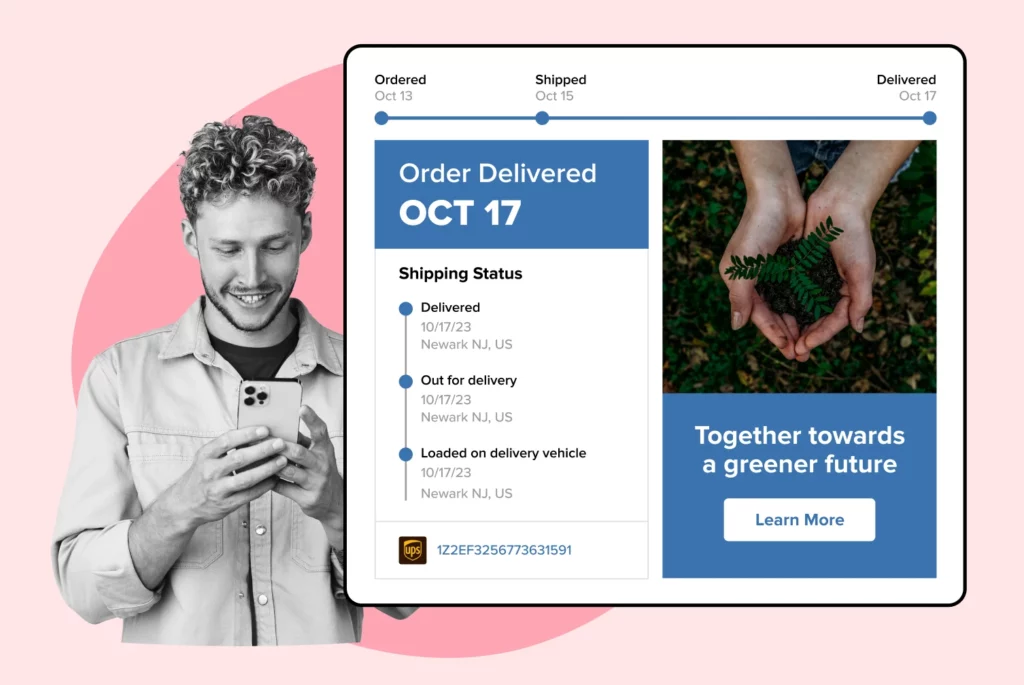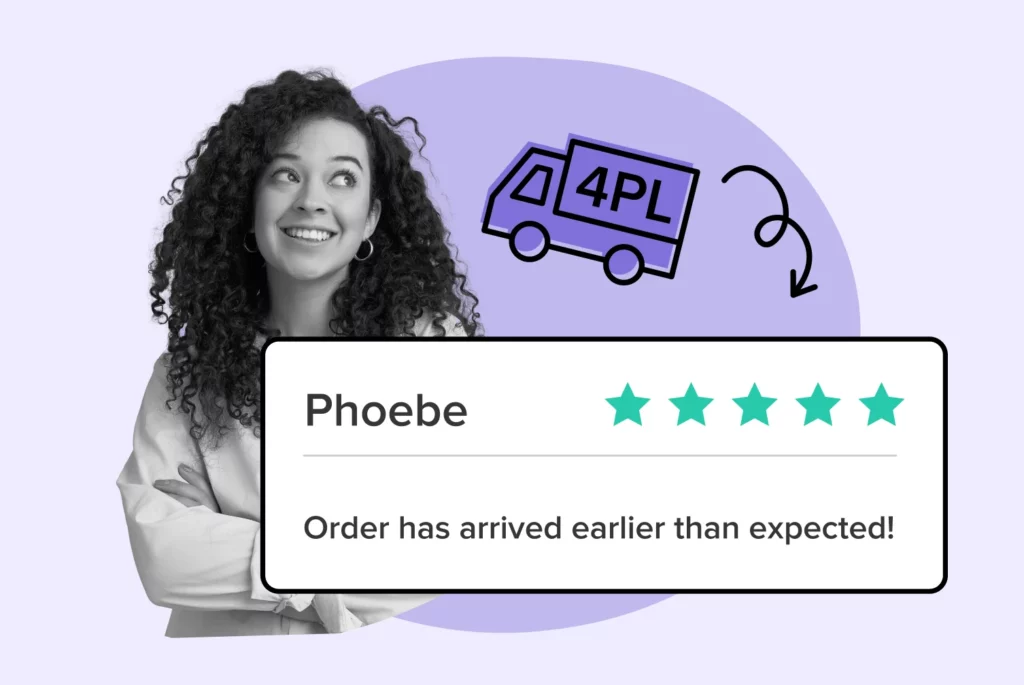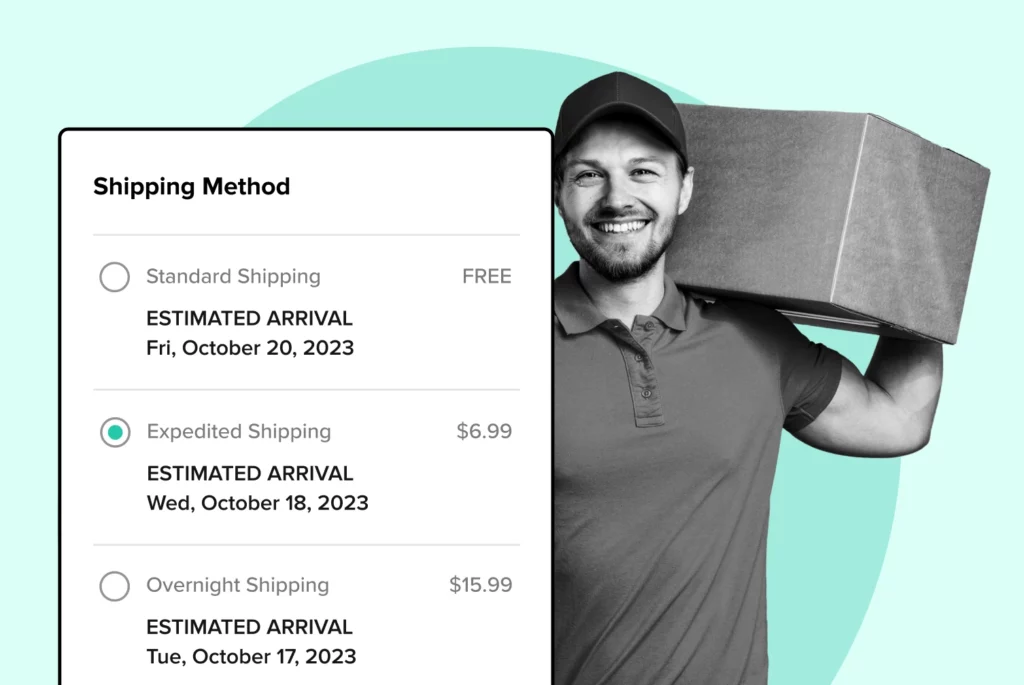
What is Pick and Pack Fulfillment in eCommerce?
This post will explore pick and pack ecommerce fulfillment, covering its significance, optimization, challenges, and future trends.
Boost customer experience and reduce support tickets
Realtime order and shipment tracking
Proactive order and shipping notifications
Predictive pre-purchase estimated delivery dates
Self-Serivce branded order tracking
Effortless experience delivered
Make returns profitable and delight customers
Flexibility to define any return destinations & conditions
Simplify returns for your customers and team
Incentivize exchanges over returns
Returns management made easy for your team
Understand why your customers are returning
Unify the online and the in-store experience
Hassle-free pickup experience for customers
In-Store Dashboard to keep operations streamlined
In-Store and Online orders unified
Drive foot-traffic to your stores
Boost customer experience and reduce support tickets
Realtime order and shipment tracking
Proactive order and shipping notifications
Predictive pre-purchase estimated delivery dates
Self-Serivce branded order tracking
Effortless experience delivered
Make returns profitable and delight customers
Flexibility to define any return destinations & conditions
Simplify returns for your customers and team
Incentivize exchanges over returns
Returns management made easy for your team
Understand why your customers are returning
Unify the online and the in-store experience
Hassle-free pickup experience for customers
In-Store Dashboard to keep operations streamlined
In-Store and Online orders unified
Drive foot-traffic to your stores
Find the answer to all your questions
Explore the most comon questions about WeSupply
Calculate the ROI that WeSupply can bring you
Request a no strings attached review of your current shopping experience and missed conversion opportunities
Take a step by step trip through our functionality to see how we can improve your ecommerce processes.
Read actionable articles on how to optimize your post-purchase experience and decrease support tickets
Get inspired by stories of how our customers implemented an effortless post-purchase experience
A Deep Dive into Top Companies' Order Tracking & Returns Strategy
Wondering if WeSupply is a good fit for you? Read through our use cases to see how we can help you increase conversion & improve CX!

Picture this: you’ve ordered a product online, eagerly anticipating its arrival. You check the tracking information daily, and the expected delivery date is approaching. Suddenly, you receive a notification that there’s a delivery exception. What does this mean, and when can you expect your package to arrive? Delivery exceptions are an unfortunate reality in the ecommerce landscape, affecting not only customer satisfaction but also a business’s reputation. In this article, we’ll delve into the world of delivery exceptions, examining the causes, prevention strategies, and management techniques to help businesses and customers alike navigate this challenge.
This article explores the concept of delivery exceptions in ecommerce and offers strategies to prevent, manage, and navigate them.
It provides an overview of common scenarios with real-life examples as well as root causes and classifications.
Businesses should implement address verification procedures, weather-resistant labels, proper documentation processes, carrier delivery management tools for transparent communication with customers to ensure seamless deliveries and maintain customer satisfaction.
Leveraging WeSupply’s post-purchase order tracking and notifications capabilities ensures transparent, real-time shipping updates, enhancing customer satisfaction and reducing anxiety amid delivery exceptions. The platform adeptly manages peak traffic and potential delays, providing precise Estimated Delivery Dates, thereby maintaining a consistently informed and positive customer experience.
In the era of online shopping, customers expect a seamless experience from browsing to receiving their packages. Delivery exceptions, however, can disrupt this process and result in dissatisfaction, ultimately affecting a business’s reputation and customer loyalty. To meet customer expectations and maintain a competitive edge, businesses must understand the intricacies of delivery exceptions and implement effective strategies to handle them.
We start by defining delivery exceptions and exploring their impact in the ecommerce landscape.
A delivery exception is an unforeseen delay in package transit due to various factors, such as:
incorrect addresses
weather-related issues
customs delays
documentation problems
DHL delivery exceptions
FedEx delivery exception
The term “delivery exception” might sound alarming, but it doesn’t necessarily mean the package is lost or severely delayed. In most cases, it indicates that the package’s arrival will be delayed, but it will eventually reach its destination.
Grasping the significance of delivery exceptions in eCommerce is vital for businesses. Delivery exceptions can impact customer satisfaction and brand reputation. For instance, 51% of customers expect brands to provide compensation, such as a reimbursement or a coupon code for future orders, when a delivery is not fulfilled. Hence, businesses must promptly monitor and address delivery exceptions. to minimize their impact on customer satisfaction.
WeSupply streamlines compensation processes, offering customers flexible options during returns, such as exchanging items for equal, lower or higher-value, effortlessly integrating this feature into the standard procedure. It promotes instant store credit, an appealing substitute for traditional refunds, enhancing customer retention and encouraging future transactions. Its automated platform efficiently handles refunds, store credits, and gift cards, simplifying the return journey while maximizing customer satisfaction and loyalty.
Throughout this article, we will explore the various causes and classifications of delivery exceptions. We will also discuss strategies to prevent and manage delivery exceptions, such as address verification, weather-resistant labels, and compliance with documentation and procedures.
Additionally, we will cover proactive measures like transparent communication, partnering with multiple carriers, and leveraging technology to help businesses effectively navigate delivery exceptions and maintain customer satisfaction.
Grasping the adverse effect of delivery exceptions on customer experience and business reputation is vital. A delivery exception can occur for a variety of reasons and often at the most inopportune times. While some factors contributing to delivery exceptions are beyond the control of businesses, understanding the causes and effectively managing them can help mitigate their impact on customer satisfaction.
We’ll further explain the concept of delivery exceptions. and explore common scenarios and real-life examples of delivery disruptions.
A delivery exception is an unintentional and unavoidable issue that can cause delays or other disruptions in the delivery process, leading to an exception status. The most common causes of delivery exceptions include incorrect addresses, weather-related problems, and customs or documentation issues. Understanding what a delivery exception means can help businesses take appropriate actions to minimize their impact when delivery exceptions occur.
For example, if a FedEx delivery exception occurs due to an incorrect address, the shipping carrier may be unable to deliver the package on the originally stated delivery date. In such cases, businesses must contact the carrier and the customer, provide updated information, and expedite the resolution process. By addressing the issue promptly, businesses can maintain customer satisfaction and trust.
Delivery disruptions can occur for various reasons, and real-life examples can help illustrate the importance of addressing these issues. Some common scenarios include Address Unknown, Damage to Shipment, and Signature Not Received. For instance, a package may be delayed due to a snowstorm, or a customer may submit an incorrect address, leading to the package being delivered to the wrong location.
Additionally, customs delays can also cause significant disruptions in package transit, especially in international shipping. In such cases, businesses must ensure proper documentation and compliance with customs regulations to minimize delays and maintain customer satisfaction. By staying informed about the common causes of delivery disruptions and addressing them proactively, businesses can reduce the likelihood of delivery exceptions and ensure a smooth delivery process.
In such situations, prioritizing the provision of accurate delivery estimates to customers is paramount for elevating their satisfaction levels. Utilizing tools like WeSupply, businesses can distinctly display Estimated Delivery Dates for all shipping options, from the product page through to checkout. Furthermore, leveraging WeSupply’s post-purchase notification system ensures customers are consistently apprised of every stage in their order’s journey, thereby mitigating uncertainties and enhancing their overall shopping experience.
A variety of issues can cause delivery exceptions., including address and weather-related factors, customs, and documentation problems. By understanding the root causes and classifications of delivery exceptions, businesses can develop effective strategies to prevent and manage them.
We’ll delve into the specific causes of delivery exceptions. and explore how businesses can navigate these challenges.
Address and weather-related issues are common causes of delivery exceptions. Incorrect addresses can lead to packages being misdelivered or returned to the sender. To avoid such issues, businesses should implement address verification procedures to ensure accurate delivery information. Furthermore, weather-resistant labels can be utilized to protect packages from environmental factors such as rain, snow, and heat.
Weather-related issues, such as severe storms or natural disasters, can also cause significant delays in package transit. While businesses cannot control the weather, they can monitor weather conditions and adjust delivery routes or schedules accordingly to minimize potential disruptions. By addressing address and weather-related issues proactively, businesses can reduce the likelihood of delivery exceptions and maintain customer satisfaction.
Customs and documentation problems, such as missing documentation, can also lead to delivery delays and disruptions, particularly in international shipping. Incomplete documents, errors in tariff codes, and backlogs at ports can cause customs delays, resulting in delivery exceptions. To prevent such issues, businesses should ensure proper documentation and compliance with customs regulations.
Other diverse challenges, such as labor shortages, flight delays, or unforeseen events, can also contribute to delivery exceptions. By staying informed about potential challenges and implementing flexible contingency plans, businesses can adapt to these disruptions and minimize their impact on delivery processes.
In the ever-evolving world of ecommerce, addressing these diverse challenges is crucial for maintaining customer satisfaction and ensuring smooth deliveries.
In the realm of eCommerce, high traffic periods, specific cutoff times, and holiday seasons present unique challenges and opportunities for businesses. These times often come with a surge in demand, putting immense pressure on logistics, inventory management, and customer service. However, by integrating strategic elements such as clear Estimated Delivery Dates (EDDs) and flexible shipping rules, businesses can significantly enhance customer trust and satisfaction during these peak times.
In relation to delivery exceptions, transparency and communication are paramount. Unforeseen issues in the supply chain, such as delays, lost packages, or logistic errors, are inevitable, particularly during high traffic seasons. However, businesses that utilize advanced post-purchase optimization software can mitigate these challenges by providing real-time updates and clear communication about backorders and stock status. This proactive approach allows for the classification and quick identification of root causes when exceptions occur, enabling swift resolution strategies and maintaining customer satisfaction.
Businesses should employ various strategic measures to effectively prevent and manage delivery exceptions., such as address verification, weather-resistant labels, and proper documentation procedures. By employing these strategies, businesses can minimize the occurrence of delivery exceptions and maintain customer satisfaction.
Address verification is key to ensuring the accuracy of delivery information, including the delivery address, and preventing delivery exceptions caused by incorrect addresses. Businesses should implement address verification procedures to validate customer addresses and minimize potential delivery issues.
Additionally, using weather-resistant labels can help protect packages from environmental factors such as rain, snow, and heat. By employing these strategies, businesses can reduce the likelihood of delivery exceptions caused by address and weather-related issues.
Compliance with documentation and procedures is another vital aspect of preventing delivery exceptions, particularly in international shipping. Ensuring proper documentation and compliance with customs regulations can help prevent customs-related delays and disruptions. Furthermore, adhering to domestic and international protocols can help businesses maintain smooth delivery processes and avoid potential issues.
By implementing these strategic prevention and management measures, businesses can reduce the occurrence of delivery exceptions and ensure a seamless delivery experience for their customers.
In addition to strategic prevention and management, businesses can also implement proactive measures to handle delivery exceptions effectively. These measures include transparent communication, partnering with multiple carriers, and implementing technology solutions to anticipate and address potential issues.
Maintaining trust and loyalty requires transparent and timely communication with customers during delivery disruptions. By keeping customers informed about any potential issues or delays, businesses can manage expectations and minimize dissatisfaction. Utilizing carrier delivery management tools, such as real-time tracking and visibility, can help businesses provide accurate and up-to-date delivery status information to their customers.
In addition, businesses should also be proactive in communicating any changes or updates to delivery dates, ensuring that customers are kept informed of any potential delays or disruptions. By maintaining open and prompt communication with customers, businesses can foster trust and loyalty, even when faced with delivery exceptions.
WeSupply enhances customer communication and satisfaction through advanced order tracking and proactive shipping notifications, prioritizing transparent and timely updates from shipment to delivery. With the integration of personalized, branded tracking pages and predictive pre-purchase delivery estimates, it enables businesses to offer a seamless post-purchase journey, minimize anxieties, and build robust customer loyalty, while deftly managing potential disruptions in the delivery pipeline.
Answer the #1 Customer Service Question: Where is My Order?
Book a quick call with our experts to see how WeSupply can help you give customers the ability to track their orders on your website to decrease the number of WISMO support tickets.
Partnering with multiple carriers can provide several benefits for businesses:
Avoiding delivery disruptions
Providing redundancy in case one carrier experiences delays or disruptions
Ensuring prompt and dependable package delivery
Maintaining customer satisfaction and loyalty
By diversifying across multiple carriers, businesses can enjoy these advantages.
Furthermore, collaborating with multiple shipping carriers enables businesses to evaluate rates, transit times, and routes, allowing them to select the most economical and efficient shipping method for each shipment. This flexibility can help businesses optimize their logistics operations and better manage delivery exceptions.
Technology solutions can play a significant role in helping businesses anticipate and mitigate delivery issues. Some examples of these solutions include:
Delivery Exception Management systems
Predictive alerts
Real-time visibility tools
Map-integrated routing technology
Platforms notifying users of potential problems
By utilizing these tools, businesses can anticipate and address delivery exceptions more effectively.
By leveraging these technologies and tools, businesses can achieve quicker and more efficient deliveries, meeting consumer expectations and reducing the likelihood of delivery exceptions. Implementing technology solutions not only ensures a better customer experience but also helps businesses adapt to the ever-evolving ecommerce landscape.
Implementing WeSupply’s technology allows businesses to leverage precise Estimated Delivery Dates, enhancing customer trust by factoring in variables like holidays and store timings, thereby mitigating potential discrepancies and issues in delivery expectations.
Beyond strategic prevention and management, it is vital to delve into the tactical strategies for preventing delivery exceptions. Implementing robust shipping practices and ensuring compliance with international and domestic protocols can help businesses minimize the occurrence of delivery exceptions and maintain customer satisfaction.
We’ll delve into these tactical approaches in more detail.
Proper shipping and labeling practices are crucial for reducing the risk of delivery issues. Ensuring accurate and complete information on shipping labels can help prevent delivery exceptions caused by incorrect addresses or damaged labels. In addition, implementing weather-resistant packaging and labels can provide protection against extreme weather conditions, further reducing the likelihood of delivery exceptions.
By adopting robust shipping and labeling practices, businesses can ensure that packages arrive promptly and undamaged, with the correct address and labeling information included. This not only helps to minimize delivery exceptions but also enhances customer satisfaction.
Balancing international and domestic protocols is another vital aspect of preventing delivery exceptions. Ensuring proper documentation and compliance with customs regulations is crucial for smooth delivery processes, especially in international shipping. Businesses should stay informed about any changes in customs regulations and collaborate with reliable carriers to ensure compliance.
By adhering to international and domestic protocols, businesses can maintain smooth delivery processes and avoid potential issues caused by customs and documentation problems. This proactive approach to compliance can help businesses minimize delivery exceptions and ensure a seamless delivery experience for their customers.
To effectively manage delivery exceptions, businesses need a step-by-step guide that encompasses real-time management, implementation of best practices, and emerging techniques in exception handling. In this section, we will provide an analytical step-by-step guide for handling delivery exceptions, from identification to resolution.
Real-time management of delivery exceptions is crucial for quick and efficient issue resolution. By actively monitoring and addressing delivery issues as they occur, businesses can minimize delays and improve customer service. Utilizing technologies such as real-time tracking and visibility can help businesses promptly identify and respond to delivery exceptions, ensuring timely resolution of any issues that may arise during the delivery process.
Moreover, businesses should also be proactive in communicating any changes or updates to delivery dates, ensuring that customers are kept informed of any potential delays or disruptions. By practicing real-time management of delivery exceptions, businesses can better manage customer expectations and maintain customer satisfaction.
Adopting best practices and emerging techniques in exception handling can help businesses adapt to challenges and minimize the occurrence of delivery exceptions. Some key strategies to consider include:
Ensuring stringent procedures for shipping and labeling
Managing delivery issues in real-time from identification to resolution
Formulating communication strategies to preserve trust and loyalty
By implementing these practices, businesses can effectively handle exceptions and maintain a high level of customer satisfaction.
Moreover, businesses should also stay informed about the latest trends and technologies in ecommerce logistics, as well as the potential challenges that may arise in the future. By staying ahead of the curve and implementing best practices and emerging techniques, businesses can better manage delivery exceptions and ensure a seamless delivery experience for their customers.
Maintaining customer satisfaction amidst delivery exceptions requires a customer-centric approach. This approach emphasizes:
Resolving the issue promptly and effectively
Ensuring that the customer feels valued and satisfied with the resolution
Proactive communication
Personalized solutions
A willingness to go above and beyond to meet the customer’s expectations
These are all integral components of a customer-centric approach.
We’ll examine how businesses can maintain satisfaction amidst exceptions through effective communication and personalized solutions.
Crafting effective communication strategies is crucial for maintaining customer trust and loyalty during delivery disruptions. By keeping customers informed about any potential issues or delays, businesses can manage their expectations and minimize dissatisfaction. Utilizing carrier delivery management tools, such as real-time tracking and visibility, can help businesses provide accurate and up-to-date information to their customers.
In addition, businesses should also be proactive in communicating any changes or updates to delivery dates, ensuring that customers are kept informed of any potential delays or disruptions. By maintaining open and prompt communication with customers, businesses can foster trust and loyalty, even when faced with delivery exceptions.
Analyzing different outcomes and formulating customer-oriented solutions can help businesses navigate delivery exceptions and maintain customer satisfaction. By understanding the specific needs and concerns of each customer, businesses can tailor their approach to address the unique challenges that may arise during the delivery process.
For example, if a customer is particularly concerned about the timely delivery of their package, businesses can prioritize expedited shipping options or partner with multiple carriers to ensure prompt delivery. By taking a customer-centric approach, businesses can effectively balance satisfaction amidst exceptions and maintain a positive customer experience.
Achieving logistical mastery involves harnessing technology and tools to enhance delivery processes and prevent exceptions. These advancements can help businesses optimize their logistics operations, reduce delivery exceptions, and improve customer satisfaction.
This section discusses how businesses can utilize technology and tools to improve their delivery processes.
Ecommerce logistics advancements, such as software and management tools, can help businesses manage delivery exceptions by automating order tracking, route optimization, and providing real-time visibility into the delivery process. These tools can assist businesses in recognizing and predicting delivery exceptions, as well as offering immediate insight into the delivery process, enabling prompt, effective, and cost-efficient resolution.
By utilizing advanced ecommerce logistics software and management tools, businesses can better manage delivery exceptions, reduce the likelihood of disruptions, and improve customer satisfaction. Leveraging these tools not only ensures a better customer experience but also helps businesses adapt to the ever-evolving ecommerce landscape.
Embracing the forefront of eCommerce logistics, WeSupply integrates innovative software and adept management tools to revolutionize customer communication and satisfaction. The platform not only streamlines advanced order tracking and proactive shipping notifications but also champions the implementation of personalized, branded tracking pages and insightful predictive pre-purchase delivery estimates. By assimilating these technologically advanced features, WeSupply deftly manages potential disruptions, ensuring a seamless, transparent post-purchase journey, thereby fortifying customer loyalty and confidence throughout their purchasing experience.
Predictive pre-purchase estimated delivery dates
Book a quick call with our experts to see how WeSupply can help you set the appropriate expectations from the start and boost your conversion along the way.
The future of ecommerce logistics involves continuous improvement and adaptation to emerging challenges. Automation, robotics, shorter supply chains, and the utilization of technologies such as blockchain and augmented reality are just some of the future developments in ecommerce logistics. These advancements are intended to enhance efficiency, speed, and customer experience in ecommerce logistics.
To stay ahead in the dynamic world of ecommerce, businesses must be prepared to adapt to these emerging challenges and continuously improve their logistics operations. By staying informed about future developments and investing in the necessary tools and technologies, businesses can ensure seamless deliveries and maintain customer satisfaction even in the face of evolving logistical challenges.
Effectively managing delivery exceptions is crucial for ensuring seamless deliveries in a dynamic ecommerce landscape. By comprehending the nuances of delivery exceptions and applying a mix of strategic prevention, proactive measures, and customer-centric strategies, businesses can reduce the occurrence of delivery exceptions and uphold customer satisfaction.
As the world of ecommerce continues to evolve, businesses must stay informed about emerging challenges and adapt to the ever-changing landscape to ensure the timely and efficient delivery of packages to their customers.
Throughout this article, we have explored various strategies, challenges, and adaptive mechanisms for managing delivery exceptions. We’ve emphasized key factors, such as:
The importance of address verification
Weather-resistant labels
The advantages of partnering with multiple carriers
The use of technology
Minimizing delivery exceptions and retaining customer satisfaction are essential for businesses, and one way to achieve this is by offering price and delivery guarantees.
As businesses continue to evolve and adapt to the changing ecommerce landscape, implementing these strategies and staying informed about future developments will be crucial for maintaining seamless deliveries and ensuring customer satisfaction. Embracing a proactive and customer-centric strategy allows businesses to navigate delivery exceptions’ complexities and enhance their overall logistics operations.
As the ecommerce landscape continues to expand and evolve, businesses must stay agile and adapt to emerging challenges. By utilizing technology, applying strategic prevention measures, and embracing a customer-centric approach, businesses can guarantee smooth deliveries and uphold customer satisfaction in a dynamic ecommerce environment.
The future of ecommerce logistics lies in:
Continuous improvement
Adaptation
The pursuit of logistical mastery to overcome delivery exceptions
Ultimately deliver an exceptional customer experience.
In conclusion, managing delivery exceptions effectively is a critical aspect of ensuring seamless deliveries and maintaining customer satisfaction in the dynamic world of ecommerce. Businesses must understand the causes of delivery exceptions, implement strategic prevention and management measures, and embrace a customer-centric approach to navigate these challenges successfully. By staying informed about emerging logistical challenges and continuously improving their logistics operations, businesses can ensure a better customer experience and stay ahead in the competitive world of ecommerce.
WeSupply mitigates shipping challenges, particularly delivery exceptions, by offering a sophisticated post-purchase tracking and notification system that keeps customers perpetually informed and satisfied. Through proactive communications, predictive pre-purchase delivery estimates, and the provision of timely updates during unforeseen delivery disruptions, the software enhances customer experience and loyalty, while also serving as a strategic tool to manage e-commerce operations effectively and transparently.
If you receive a delivery exception, it’s important to check the details and contact the carrier or sender as needed to resolve the issue and minimize any impact on delivery time. Contacting the carrier and the customer are your first steps in order to address the issue.
A shipment exception usually lasts less than seven days, depending on its cause.
FedEx uses the term “delivery exception” to tag situations where delivery or shipment of an item is “non-standard,” which can range from weather-related delays, incorrect shipping information, customs delays, and issues with package contents or packaging. Delivery exceptions can also occur when a signature is required at the recipient’s address but no one is available.
Businesses can prevent delivery exceptions by verifying addresses, using weather-resistant labels, ensuring proper documentation and customs compliance, and partnering with multiple carriers.
The future of ecommerce logistics looks promising, with the implementation of automation, robotics, shorter supply chains, and innovative technologies like blockchain and augmented reality driving improvements and adaptations.

Learn How To Create Successful Post Purchase Email Campaigns
Build an effective post-purchase email flow that helps you increase customer satisfaction and drive revenue growth!

This post will explore pick and pack ecommerce fulfillment, covering its significance, optimization, challenges, and future trends.

In this comprehensive guide, we’ll delve into the concept of cross-docking and explore its history, benefits, challenges, and best practices.

Discover how safety stock can transform your retail business and prepare you for the future of customer-centric inventory management.

Join us as we explore the what, why, and how of the shift towards carbon neutral shipping in the world of logistics.

In this post, we’ll dive into the world of 4PL logistics, its benefits, challenges, and how it compares to more traditional logistics models.

This article offers a detailed comparison of standard and expedited shipping in e-commerce, helping you make informed logistics choices.

As we dive into the intricacies of inbound logistics, we will explore its challenges, as well as best practices for optimizing its processes.

In this blog post, we’ll explore the ins and outs of SFP, including eligibility requirements, advantages, and strategies for success.

Read on to discover the world of pick lists, their components, and how they contribute to the smooth operation of warehouses.